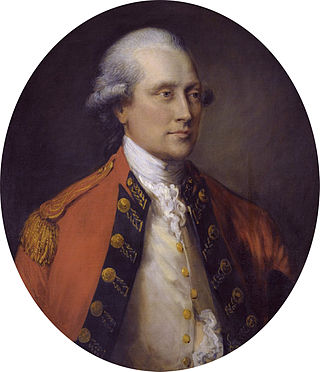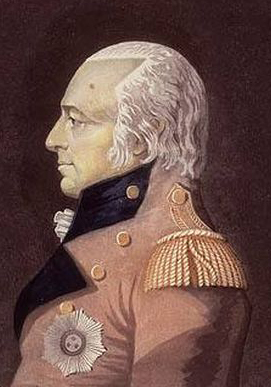Andrew Gordon | |
|---|---|
| Died | 17 April 1806 |
| Allegiance | |
| Service | British Army |
| Rank | Lieutenant General |
| Commands | Garrison of Jersey |
Lieutenant General Andrew Gordon (died 17 April 1806) was a British Army officer who became Lieutenant Governor of Jersey.
Andrew Gordon | |
|---|---|
| Died | 17 April 1806 |
| Allegiance | |
| Service | British Army |
| Rank | Lieutenant General |
| Commands | Garrison of Jersey |
Lieutenant General Andrew Gordon (died 17 April 1806) was a British Army officer who became Lieutenant Governor of Jersey.
He was a son of James Gordon of Ellon, Aberdeenshire and Elizabeth Glen, the latter being a sister of James Glen, governor of South Carolina. [1] His brother was Lieutenant Colonel James Gordon. [1]
Born in Scotland, Gordon became a major in the 26th Regiment of Foot in 1777. [2] He was promoted to lieutenant-colonel in 1784, colonel in 1790, [3] major-general in 1794, [4] and lieutenant-general in 1801 (from brevet, 1799). [5] He was appointed Lieutenant Governor of Jersey in 1797 [2] [6] and died in office in 1806. [2]
He was also Colonel of the 89th Regiment of Foot from 1795 to 1797, the 59th Regiment of Foot from 1797 to 1801 and Colonel of the 26th Regiment of Foot from 1801 to his death in 1806. [2]

Field Marshal John Campbell, 5th Duke of Argyll, styled Marquess of Lorne from 1761 to 1770, was a Scottish soldier and nobleman. After serving as a junior officer in Flanders during the War of the Austrian Succession, he was given command of a regiment and was redeployed to Scotland where he opposed the Jacobites at Loch Fyne at an early stage of the Jacobite Rebellion and went on to fight against them at the Battle of Falkirk Muir and then at the Battle of Culloden. He later became adjutant-general in Ireland and spent some 20 years as a Member of Parliament before retiring to Inveraray Castle.

Charles Grey, 1st Earl Grey, was a British Army general in the 18th century and a scion of the noble House of Grey. He was a distinguished soldier in a generation of exceptionally capable military personnel, serving crucially in the Seven Years' War (1756–1763), the American Revolutionary War and the French Revolutionary Wars.

General Sir James Henry Craig KB was a British Army officer and colonial administrator who served as the Governor General of British North America from 1807 to 1811.

Sir George Nugent, 1st Baronet, GCB was a British Army officer. After serving as a junior officer in the American Revolutionary War, he fought with the Coldstream Guards under the Duke of York during the Flanders Campaign. He then commanded the Buckinghamshire Volunteers in the actions of St. Andria and Thuyl on the river Waal and participated in the disastrous retreat from the Rhine. He went on to be commander of the northern district of Ireland, in which post he played an important part in placating the people of Belfast during the Irish Rebellion, and then became Adjutant-General in Ireland. He went on to be Governor of Jamaica, commander of the Western District in England, commander of the Kent District in England and finally Commander-in-Chief, India.

Sir Alured Clarke was a British Army officer. He took charge of all British troops in Georgia in May 1780 and was then deployed to Philadelphia to supervise the evacuation of British prisoners of war at the closing stages of the American Revolutionary War. He went on to be Governor of Jamaica and then lieutenant-governor of Lower Canada in which role he had responsibility for implementing the Constitutional Act 1791. He was then sent to India where he became Commander-in-Chief of the Madras Army, then briefly Governor-General of India and finally Commander-in-Chief of India during the Fourth Anglo-Mysore War.

Lieutenant-General Sir Charles Stuart was a British Army officer and politiciain. The fourth son of John Stuart, 3rd Earl of Bute and Mary Wortley Montagu, he was born in Kenwood House, London. There is a famous painting in the Tate Gallery, London, of him aged 10 stealing eggs and chicks from a bird's nest.

General James Stuart (1741–1815) was a British Army officer who served in North America during the American Revolutionary War and took part in various campaigns in British India. He was the first General Officer Commanding, Ceylon and second Military Governor of British Ceylon. He was appointed on 1 March 1796 and was Governor until 1 January 1797. He was succeeded by Welbore Ellis Doyle.

General Sir Hew Whitefoord Dalrymple, 1st Baronet was a Scottish general in the British Army and Governor of Gibraltar.
General Sir Lewis Grant, KCH was a British Army officer and colonial administrator in the Caribbean.

Field Marshal Sir Samuel Hulse, GCH was a British Army officer. He saw his first active duty during the Gordon Riots in June 1780 before commanding the 1st Battalion of the 1st Regiment of Foot Guards at key battles of the Flanders Campaign during the French Revolutionary Wars. He also commanded the 1st Guards Brigade at a later battle and then joined the retreat into Germany during the closing stages of the Flanders Campaign. He later took part in the Anglo-Russian invasion of Holland and then returned to England to become General Officer Commanding South East District. After completing active service in the Army, he served in the household of King George IV.
Lieutenant-General Sir James Frederick Lyon was a British army officer and colonial administrator who served as the governor of Barbados from 1829 to 1833.

General Sir David Dundas was a British Army officer who fought in the Seven Years' War and French Revolutionary Wars, wrote important texts on the Principles of Military Movements and then served as Commander-in-Chief of the Forces from 1809 to 1811.
Lieutenant General Sir William Thornton KCB was a British Army officer who served as Lieutenant Governor of Jersey.

Lieutenant-General Sir Hugh Lyle Carmichael was a British Army officer and colonial administrator who served as the lieutenant-governor of Demerara and Essequibo from 1812 to 1813, when he died in office. He also was commander of the British forces at the 1808 siege of Santo Domingo and was a strong proponent of giving the West India Regiments equal treatment to white British troops.
General Alexander Ross (1742–1827) was a British officer who served in the American War of Independence and in India, rising to the rank of general. He was a close friend of Charles Cornwallis, 1st Marquess Cornwallis.
Lieutenant-General Hon. John Meade CB was an Irish officer in the British Army. After leaving the professional army he served as a militia officer in Ireland, and sat in the House of Commons of the United Kingdom for twelve years before taking up a diplomatic post.
Lieutenant-General Sir Henry George Grey GCB GCH was a British Army officer who served as acting Governor of Cape Colony.
Lieutenant-General Francis D'Oyly (c.1750–1803) was a British Army officer.
General Gordon Forbes was a senior officer in the British Army.
Lieutenant-Colonel James Gordon, the third and last Laird of the barony of Ellon, was a highly regarded British Army officer who fought in the American Revolutionary War. In 1782, he played a role in the Asgill Affair, the controversial confinement and proposed execution of British Captain Charles Asgill.